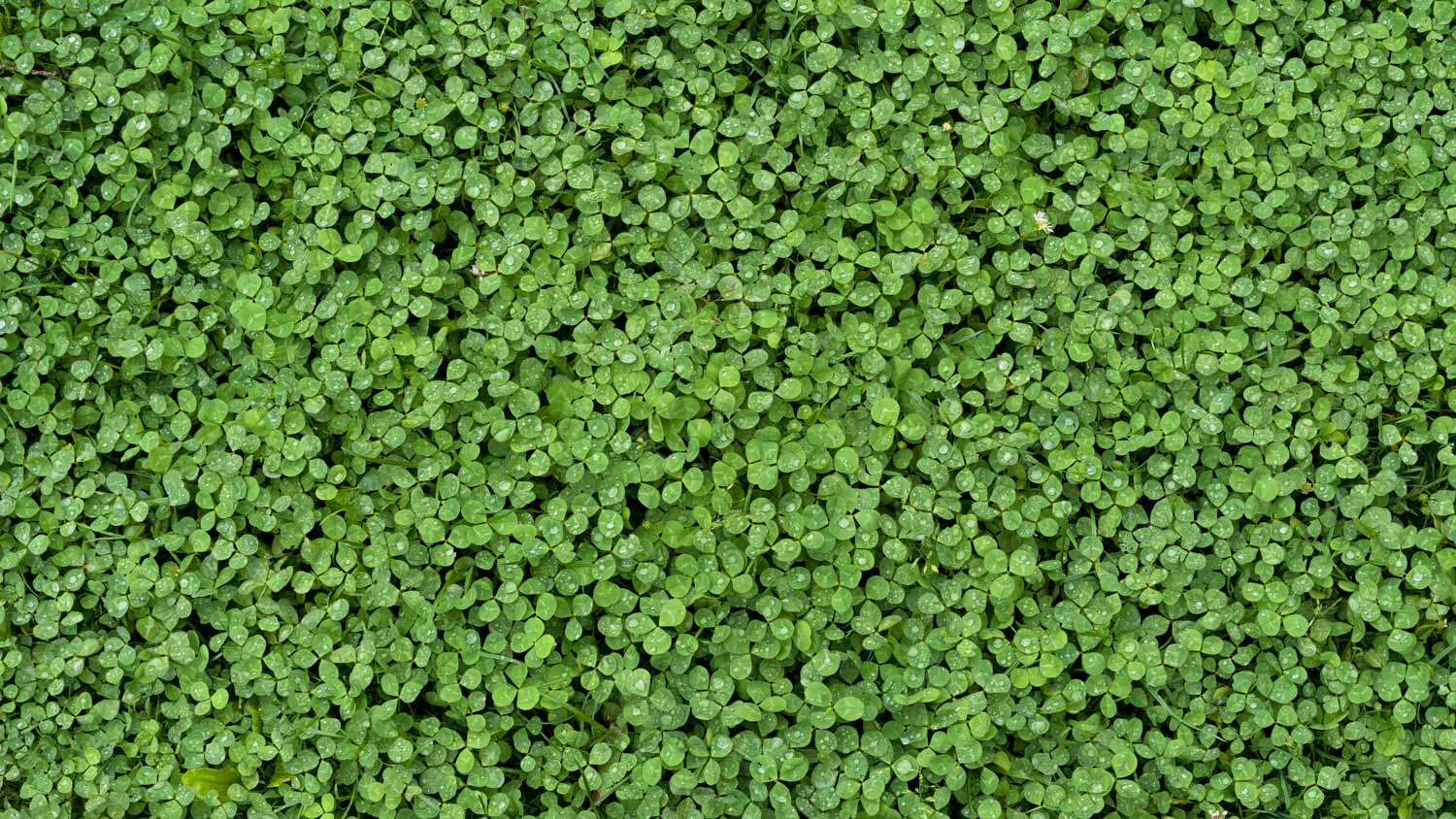The Pros and Cons of a Clover Lawn
Your clover lawn comes with its own batch of good luck


Clover lawns are low-maintenance, sustainable, and highly durable in a range of conditions.
The downside of clover lawns is that they require extensive prep, attract bees, and don’t hold up well to heavy foot traffic.
Clover lawns take time and work to plant, but are highly self-sufficient once established.
Consult a lawn care professional to determine whether your yard is a strong candidate for a clover lawn.
It's official—word is getting out about grass alternatives that require less mowing, watering, and overall fussy maintenance. The rather lucky clover lawn is gaining attention in the landscaping world. If you're looking to make the switch yourself, start by weighing clover lawn pros and cons for your unique lawn.
What Is a Clover Lawn?

A clover lawn is just as it sounds—a lawn composed of one or more popular clover varieties to take the place of traditional grass. Known for its low maintenance, deep roots, and lush appearance, some homeowners prefer a clover as an attractive yet eco-conscious option for their lawn. Homeowners may either fill their entire lawn with clover or mix it with a popular grass variety for their area.
Clover lawn viability varies based on where you live and the species you choose. For example, dutch white clover is a popular option and features white flowers that attract bees and pollinators. Microclover is another hardy variety and offers a more cohesive green across your lawn. Strawberry and red clover are additional options for more temperate climates, and win points for their tolerance in tricky soil.
| Pros of a Clover Lawn | Cons of a Clover Lawn |
|---|---|
| Drought-tolerance | Extensive prep |
| Minimal mowing | May invade other spaces |
| Adds nitrogen to the soil | Weak against foot traffic |
| Tolerant in sun and shade | Inconsistent with grass in winter |
| Encourage pollinators | Attracts bees (not ideal for kids) |
| Pest resistant |
Pros of Planting a Clover Lawn
The more you learn about clover, the clearer it becomes that they make a great lawn alternative. These deep-rooted, erosion-stopping plants can create a stunning landscape without all the work, water, and fertilizers.
Drought-Tolerance
If you’re aiming to cut down on water use, clover offers a great option in times of drought. Its deep roots reach further into the soil for moisture, meaning that—once established—you may only need to water your clover lawn once a week. During the rainy season, you can skip irrigation altogether.
Minimal Mowing
Here's where clover truly shines. As your neighbor breaks out the mower once a week in the height of summer, clover lawns only require mowing—get this—twice a year. The clover's slow growth offers a tidy and natural lawn with one trim during the high season and one more before it goes dormant in the late fall.
Nitrogen Production
Poor soil conditions are some of the most common issues in lawns. However, clover can add nitrogen to your soil, allowing you to skip the fertilizer and all the maintenance that goes along with low-nutrient grass.
Shade Tolerance
Traditional grass may not thrive in areas with constant shade, such as close to your trees and along the side of your home. Most clover varieties only need between four and six hours of sun a day, meaning you get a more consistently lush lawn. If you're looking to rejuvenate your current lawn, ask your landscaper if clover would thrive in your unique landscape.
Welcomes Pollinators
Hoping to welcome more bees, butterflies, and hummingbirds to your yard? A clover lawn creates the ideal ecosystem for beneficial bugs to spend their time, supporting both your garden and the overall ecosystem.
Resists Pests
On the other side of the coin, most varieties of clover ward off common lawn pests, such as grubs and aphids. Additionally, a lusher lawn gives pests less of an opportunity to set up shop.
Clover Lawn Cons

Clover lawns are not a fix-all for landscape care and you will have to put a little more work into getting it to thrive at the beginning. Here are some downsides to consider when weighing the clover lawn pros and cons.
Extensive Preparation
Planting a clover lawn is not a complex DIY, but it can take longer to establish a strong weed-free lawn compared to grass. Testing your soil to ensure proper pH (between 6 and 7), is best, as well as choosing a nutrient-rich topsoil. Due to the longer growth time, you may also need to remove weeds by hand until the clover gains ground.
Can Be Invasive
The double-edged sword of clover lawns is their spreading ability. While this means clover will properly cover your lawn, it can also travel into unwanted areas, such as flower beds, driveway cracks, and walkways.
Traffic Weakness
If you're a big fan of holding large birthday parties, barbecues, and local dog gatherings on the lawn, your clover may struggle. Some varieties, such as microclover, hold up better against traffic, but you'll need to be careful not to trample the comparatively delicate blades.
Winter Inconsistencies
Like grass, some clover goes dormant in colder climates during the winter. Some varieties will simply slow their growth and remain green while others will turn a pale brown color. If you mix clover seed with grass, you could end up with a patchy lawn in the cold months.
Attracts Bees
This feature snuck onto both the clover lawn pros and cons list. If you have children running around the lawn—or if you're allergic to bee stings—white, red, and strawberry clover will attract far more bees than other options.
Alternatives to Planting a Clover Lawn
Clover lawns are just one of the great grass alternatives out there. There are environmentally friendly and low-maintenance options that can make your home cozy, wild, or whimsical in the process. Here are some top picks.
A collection of fine fescue grasses—also known as no-mow grass—offers a lush and wispy lawn without the constant trimming.
Creeping thyme, creeping Charlie, or creeping Jenny are all low-growing vine plants with lush green leaves and occasional flowers.
Cut out the mowing and fertilization completely with a moss lawn, a tough drought-tolerant ground cover option.
A variety of flowers such as chamomile and hostas can also act as ground cover.
Is a Clover Lawn Right for You?
A clover lawn is flexible and versatile for homes across the country. It's always best to chat with a local lawn care pro before investing in a big change, but clover lawns can trim down your landscaping in little time. If you're through with constant and water-heavy lawn care, clover could be a strong choice for you.
Frequently Asked Questions
Clover is a sustainable, low-maintenance alternative to turfgrass, allowing homeowners to put away the mower while enjoying a lush and consistent lawn. The plant also attracts pollinators, adds nitrogen to low-nutrient soil, and holds up in a range of climates. Consult a local lawn care professional to determine whether replacing your grass with clover is right for your yard.
Clover lawns stand up better against dog and cat urine than traditional turfgrass. If your pets love to hang out on the lawn on a sunny day—or if you find yourself with a lot of visiting neighborhood dogs—you could save yourself from yellow and brown patches by making the switch to a clover lawn.















